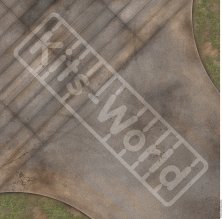
1/144 London Gatwick Airport
- Stato dello stock:Disponibile in 2-4 settimane
- Modello:KWB144517
- Marca:Kits-World
Descrizione
Kits-World - 1/144 London Gatwick Airport Size 675mm x 675mm
Founding and early years
Today, Gatwick airport is one of the United Kingdom's major airport hubs, second only to Heathrow.
Originally, partially the area now occupied by the airport was a racecourse, and was founded in 1891. From 1907, a golf course was added but this closed shortly after the end of the Great War. During the late 1920's the land adjacent to the course was purchased with a view to developing it into an aerodrome, the first operator being Dominion Aircraft Ltd with one of their own-built Avro 504's. The Surrey Aero Club was founded at the site in August 1930 by Ronald Waters of the Home Counties Aircraft Service. Pleasure flights commenced from the aerodrome the same month. Following purchase of the aerodrome by the Redwing Aircraft Company in 1932, the site was used as a flying school and in 1933, Gatwick Aerodrome was approved for commercial operations by the then Air Ministry.
The aerodrome was again bought in September 1933 for £13,500 by A. M. Jackaman with a proposal to develop the site for larger commercial operation, firstly to provide a relief location for London Airport (Croydon) and also for a planned air service to Paris Le Bourget operating the de Havilland DH.84 Dragon. The work would involve costly re-routing of the River Mole and land drainage, much of which was opposed by the Air Ministry. Eventually, Jackaman won through and the development work began, lasting through into 1934 when the aerodrome was opened for wider public service.
Gatwick's first operator was Hillman's Airways, operating services to Paris and Belfast from Gatwick until relocating there from its base of operations at Stapleford Aerodrome, near Romford, Essex in January 1935. Later that year, a merger took place involving Hillman's Airways, Spartan Air Lines (a subsidiary of Spartan Aircraft Ltd), and United Airways Ltd to form Allied British Airways Ltd. The name was later abbreviated to British Airways Ltd, and would eventually go on to form part of todays national flag carrier. This airline became Gatwick's first major carrier.
In July 1935, Gatwick was closed for improvement work, and during this time, the world's first circular terminal building was constructed. Built to the art deco style, and nicknamed The Beehive, the building opened along with the refurbished airport on 6 June 1936, although flights had re-started in May, when a Jersey Airways flight, under contract to British Airways Ltd, began operating to Paris using DH.86's. At the same time, a new British Airways route linking Gatwick and Malmo via Amsterdam, Hamburg and Copenhagen was also started, and later that month a link was established between Gatwick and the Isle of Wight. Following through June, a night mail service was started, again by British Airways Ltd and linking Cologne and Hanover. The aerodrome was linked to London Victoria by rail link.
All was well and the future looked bright until Gatwick was forced to close its large scale operations in February 1937 due to continual rainfall and the site becoming waterlogged. British Airways Ltd moved its base of operations to (London) Croydon Airport, and the site returned to sports club and pleasure flights. The Royal Air Force also set up a flying training school there with No. 19 E&RFTS (Elementary and Reserve Flying Training School) commencing operations in October 1937. In 1938, the earlier British Airways hangar was occupied by Airwork Ltd who began not only, repair, overhaul and modification operations for the RAF, but also licence-assembly of Beechcraft Expeditors and Stinson Reliants for the Royal Navy.
Storm clouds
Following the outbreak of the Second World War, civilian flights and operations from Gatwick were cancelled and the airport was passed over to Air Ministry control. One of the first functions to be carried out was repair and overhaul of Raf aircraft and also as an emergency relocation airfield for Raf Kenley in case that base was knocked out. Also at this point British Airways Ltd was merging with Imperial Airways, and Boac was founded as a result. Operating under wartime conditions and control, Boac provided a major link between Great Britain and her overseas allies, notably parts of the British Empire. Gatwick became Raf Gatwick.
In 1940, and following the British retreat from France, the Raf Army Cooperation Command began operations from Raf Gatwick using Curtiss Tomahawk I and II's of Nos. 26 and 239 Squadrons, operating as part of No. 35 Wing. By 1942, the base became an important 'put down' location for damaged or fuel-starved Raf and Usaaf bombers returning from missions, allowing repair work to be undertaken. Over the course of the war, many Raf units were stationed at Gatwick, Nos. 2, 4, 14, 18, 19, 26 (South African), 53, 57, 63, 65 (East India), 80, 92 (East India), 98, 116, 141, 168, 171, 175, 183 (Gold Coast), 229, 239, 268, 274, 287, 309 (Polish), 400, 414 (RCAF), 430 (RCAF), 613 (City of Manchester) and 655 Squadrons, along with a large number of Raf Regiment and other associated Raf units.
Post war and the 1950s
In 1946, military operations at Gatwick came to a close, and once again, civilian traffic began to return. Airwork continued its operations and Bond Air Services moved to the airport flying war-surplus Handley Page Halifax bombers converted to the cargo role. In 1947, Hunting Air Transport (later Hunting-Clan Air Transport) of Luton began operating flights from Gatwick using a de Havilland Dove and a pair of Vickers Vikings, and by January 1948 Airwork had become one of the major players in the field of aircraft conversion, maintenance and repair, servicing aircraft for British European Airways, Aer Lingus, Boac and KLM.
By the early 1950s, it was mooted to choose Stansted as London's second airport after London Airport (later Heathrow). Local public opposition to Gatwick being chosen was strong, yet the British Government went ahead and Gatwick was the winner. During these years, one of the main operators from Gatwick was British European Airways and this airline began a scheduled summer service to Alderney in 1950. Bea were joined in May of that year by Air Transport Charter of Jersey which ran a DC-3 service from Gatwick to Corsica with a stop off in Nice to refuel. The following year saw Bea relocate their Helicopter Experimental Unit from Peterborough to Gatwick, with rotary operations beginning in 1952. Also that year, Silver City Airways began car ferry flights using Bristol 170 Series 31 Freighters on the their Gatwick to Le Touquet in northern France route. However, these were upgraded to the more capable 170 Series 32 Superfreighter in 1955. Jersey Airlines commenced operations from Gatwick to Alderney in 1953 flying de Havilland DH. 114 Herons.
In 1956, the airport was closed for major overhaul and improvement which included the diversion of both the A23 London to Brighton road and the River Mole, and runways additions and improvements.
Gatwick was officially reopened by Hrh Queen Elizabeth II on June 9 1958, although Transair had already started to operate scheduled flights into the airport ferrying British troops from Malta and the airline established its base of operations at Gatwick in May. By now, Gatwick could boast state of the art facilities and was in fact the worlds first airport with a direct rail link and also the first with combined road and rail links servicing the air terminal and one of the first with enclosed piers.
By the late 1950s, air operations to and from Gatwick were increasing, with transatlantic services provided by Pan American. Also using Gatwick at this time were Capitol International, Sudan Airways, Transocean Airlines, British West Indies Airways (BWIA), President Airlines, Overseas National Airways (ONA) and a number of other European and US operators. Capitol and Ona provided an onwards link to European destinations for transatlantic US passengers. Smaller charter airlines such as Morton Air Services and Air Safaris moved to Gatwick from their London (Croydon) and Southend bases respectively.
The 1960s
One important and growing operator to move to Gatwick in 1960 was Dan-Air Services. Founded in 1953, Dan-Air initially began by operating cargo and charter flights from its Southend, and then (from 1955), Blackbushe bases before its relocation to Gatwick. By the mid-1960s, Dan-Air had begun operating the worlds first commercial jetliner, the de Havilland Comet, (in Dan-Air's case, the series 4 variant). During its latter years, the operator was a common site at destinations around the Uk and Europe. Sadly it wasn't meant to be, and Dan-Air went into liquidation in 1992 merging into British Airways.
In July 1960, British United Airways was formed at Gatwick. Airwork, which at the time owned Bristow Helicopters, Transair, Air Charter, Morton Air Services and Channel Air Bridge was merged with Hunting-Clan. Bua took over most of the duties performed by the smaller companies and steadily grew to become the largest operator based at Gatwick. A memorable sight during the mid-to late 1960s were Bua Bristol 170 Freighters and Aviation Traders ATL-98 Carvairs ferrying air passengers and their cars to and from destinations on the European mainland.
Gatwick was becoming a major hub with growth quite possibly matching that of Heathrow. Blackbushe Airport had been closed in 1960 to commercial traffic resulting in Pegasus Airlines, Orion Airways and the aforementioned Dan-Air relocating from Blackbushe to Gatwick. Additionally, Miami-based Riddle Airlines, Saturn Airways and Flying Tiger Line began operating passenger and cargo services to Gatwick, also using it as a stop-off en-route to destinations in Europe and Asia. Air France and British European Airways (BEA) began flights between Gatwick and Paris. Caledonian Airways also stepped up its operations to the airport bringing in some of the the first migrants from the West Indies to the UK, and Bua began its Silver Arrow service air/rail service between London and Paris using a Vickers Viscount for the cross-channel leg.
In 1961, Gatwick became London (Gatwick) reflecting the change of London Airport to London (Heathrow).
The mid-1960s heralded important events for Gatwick. Over the course of 1964 and 1965, improvement and lengthening work to the runways was carried out and refurbishment and upgrade of the piers and terminal was undertaken. In 1965, the first flight of the new Bac One-Eleven short haul airliner was made by Bua between Gatwick and Genoa and a Bea Hawker Siddeley Trident 1C made the first automatic approach into Gatwick. In 1966, Bua InterJet services were begun from Gatwick to destinations in Scotland and Northern Ireland, and the same year saw the start of operations by Wardair Canada, Romanian flag carrier TAROM, Kingdom of Libya (later Libyan Arab) Airlines and Ariana Afghan Airlines. New company Laker Airways also established its base of operations at Gatwick.
By this time Gatwick had become renowned as a charter airport with low-cost flights mainly to destinations in Spain and the Mediterranean by British and European carriers. This led to the slightly unflattering nickname of a bucket and spade airport. In 1967, the last car ferry flight was flown. Cross-channel ferry and hovercraft services by Seaspeed and Hoverlloyd were able to carry higher volume of vehicular traffic for lower cost. in 1968, Icelandic carrier Loftlei°er began low-cost services between Gatwick and John F. Kennedy Airport (JFK) via Reykjavik'Keflavik Airport. A shuttle service between Gatwick and Heathrow was started in 1969 by Westward Airways flying Britten Norman Islanders, cutting the transport time between the two destinations down to as little as twenty minutes. However, Westward closed this operation in August the following year.
The 1970s and expansion
In 1970, Gatwick's runway was again extended allowing larger types to be operated, and non-stop flights to the United States east coast made. Also in that year, newly-founded Bea Airtours started services from Gatwick and based their operations there. Flights from Gatwick to Palma commenced in March with de Havilland Comet 4B's. British United Airways were bought out by Caledonian Airways to become Caledonian/BUA, then in 1971, British Caledonian. In addition to the routes that both airlines operated, private-operator BCal expanded its route network over the next decade to cover wider destinations in Europe, North America, the Middle East, North and West Africa and the Far East. Low-cost airline Laker Airways began operations from Gatwick with the new McDonnell Douglas DC-10 wide-body airliner in November 1972 and in fact was the first operator of the type at the airport. Initially operating the DC-10-10 model, the fleet was expanded to include the longer-range DC-10-30 in 1980. A further runway extension was carried out in 1973, and that year heralded the dawn of the 747-era at Gatwick when Wardair and World Airways began flight operations there in May.
The second half of the decade saw BCal introduce the DC-10-30 and Laker Airways launch its famous no frills non-stop Skytrain service to JFK, with Braniff International also making stops at Gatwick. In 1978 British Airways Helicopters, BCal and the British Airports Authority (BAA) formed the Airlink helicopter shuttle service which operated a single Sikorsky S-61N, (registration G-LINK), as a fast link for business passengers between Gatwick and Heathrow.
The '80s and '90s
1980 saw the introduction of BCal's first service to Hong Kong with a stop off in Dubai. This was notable as it was the first scheduled air service to the former destination by a privately-owned operation, which BCal was. The years also saw the last flight of the de Havilland Comet in Dan-Air service marked by a special pleasure flight for enthusiasts and VIP's. BCal started Boeing 747 operations from Gatwick in 1982 when the airline purchased a small fleet of 747-200's, and BCal also took over sole operation of the Airlink service when British Airways and Baa pulled out of the venture.
Further improvement and expansion of the airport was needed due to increasing passenger numbers, and in 1983 the worlds first Automated People Mover (APM) system was installed along with a new circular satellite pier replacing the old early 1960s-era North Pier. The Apm was later replaced by a combination of moving and static walkways. Construction began of a second terminal, to be called the North Terminal, with the existing building being the South Terminal.
Virgin Atlantic began its first commercial service to the United States on June 22, 1984 when Boeing 747-200 G-VIRG Maiden Voyager left Gatwick for Newark's Liberty International Airport, and that year also saw the opening of the UK's then, tallest control tower, and also the commencement of the Gatwick Express rail link to Victoria Station in London. The first commercial flight from Gatwick by a British Airways Concorde was made in June 1985, and indeed during the previous decade BCal had also expressed interest adding the aircraft to its fleet. In the event, the 1979 energy crisis and associated costs meant that BCal had to rethink and the planned operation of the Concorde in BCal colours sadly never took place. The last Airlink flight took place on February 6, 1986. After prolonged and repeated campaigning by environmental and anti-noise pollution groups bought enough pressure to bear that BCal decided to cancel the service. It has been reported that after scrapping Airlink's S-61 ended its days sitting on a dump in Brazil re-registered as PT-HTT. 1987 saw Gatwick become the worlds second busiest international airport. Also in that year growing financial problems caused BCal to cease operations and in April 1988 the airline had been merged into British Airways. The new North Terminal was opened by Hrh Queen Elizabeth II on March 18, 1988 along with a new transit link to the South Terminal.
Although largely uneventful, the 1990s saw yet more additional building work undertaken including the addition of new international departure lounges to both the North and South Terminals and a further extension of the main runway which now measured nearly 11,000 ft. The end of the decade new low-cost carrier EasyJet began operations from Gatwick, linking to Geneva, in association with EasyJet Switzerland which was a subsidiary of the EasyJet Group.
The turn of the century and into the 2020s
New retail and catering space was added to both terminals between 2000 and 2001 with additional seating areas and an extension to the North Terminal also added. 2005 saw both the refurbishment and enlargement of the South Terminal's baggage reclaim hall and the opening of a new pier (Pier 6) and became the worlds largest air passenger bridge. Work had begun on extending the South Terminal departure lounge and by May 2008, this was completed, and the following year saw the arrival of the worlds first flight powered by natural gas-derived fuel when Qatar Airways flew one of its A340-600HGW's (High Gross Weight) into Gatwick from Doha.
Ownership of Gatwick passed from Baa to Global Infrastructure Partners (GIP) in 2009.
The new Airbus A380 was coming on stream. Currently the worlds largest passenger airliner, it was decided to test Gatwick's suitability for the type. On July 6, 2012, an Emirates A380 flew into the airport marking the first arrival of the giant aircraft. By 2013, two stands compatible with the A380 were completed and a further Emirate flight was carried out to test the new facilities. The tests were passed and in 2014, Emirates became the first operator to include Gatwick in their A380 service. Thomson began operating the first Boeing 787 Dreamliner flights into Gatwick in 2013.
The rest of the decade saw expansion and/or improvements made to the airport as part of an ongoing modernisation and continual update program. This will enable Gatwick to remain one of Europe's major and most up to date transport hubs for decades to come.
It would be a time consuming process to name every airline or carrier that has and does operate to and from Gatwick, but a selection from today and past years appears as follows:
British Airways, Air Europe, British Caledonian, Aer Lingus, Delta Airlines, Eastern Airways, Air Transat, BOAC, Imperial Airways, Virgin Atlantic, Aurigny, airBaltic, Air Malta, Easyjet, Air Arabia, Croatia Airlines, Bh Air, Bamboo Airways (scheduled to begin in late 2022), Emirates, Ryanair, Freebird Airlines, Iberia, JetBlue, Thomson, Norse Atlantic, British United Air Ferries, Corendon Airlines, Laker, Icelandair, Norse Atlantic Airways, Nouvelair, Qatar Airways, Jet2.com, Tap Air Portugal, Royal Air Maroc, Tui Airways, SunExpress, Tunisair, Turkish Airlines, Vueling, Ukraine International Airlines, Wizz Air, WestJet, Spartan Airlines, Hillman's Airways, Jersey Airways, Air France, Hunting-Clan, Dan-Air, Capitol International, Ariana Afghan Airlines, British West Indies Airways, Sudan Airways, President Airlines, Transocean Airlines, Overseas National Airways, Morton Air Services, Air Safaris, British United Airways, Orion Airways, Wardair Canada, Riddle Airlines, Flying Tiger Line, Saturn Airways, British European Airways, TAROM, Libyan Arab Airlines, Loftlei°er, Bristow Helicopters, Braniff International, Tradewinds Airways, CityFlyer Express, Gb Airways, Austrian Airlines, Aegean Airlines, Aeroflot, Aerosvit, Afriqiyah Airways (Libya), Air Berlin, Air China, Cubana, Czech Airlines, Korean Air, Northwest Airlines, Rossiya, Lufthansa, Royal Brunei, Iraqi Airways, Malev Hungarian, Sas Braathens, Olympic Airlines, KLM, Pegasus Airlines, Thomas Cook, Philippine Airlines, Swiss International Airlines, Air Tanzania, Air Moldova, Air Italy, Air Malta, Braathens SAFE, Egyptair, Avianca, China Eastern, China Airlines, Continental Airlines, Cyprus Turkish Airlines, Cobalt Air, Eastern Airlines, Belavia, Alitalia, TWA, Wow Air, Viking Airlines, Transaero, WestJet, Vietnam Airlines, Smartwings, Scandinavian Airline System (SAS), Nepal Airlines, Meridiana, Jazeera Airways, Scoot, Monarch Airlines, Royal Jordanian, Caac Airlines, Norwegian Air Shuttle, AirAsia, Air Wales, Estonian Air, Finnair, Etihad, Air One, Air Mauritius, Centralwings, American Airlines, Cimber Sterling, British Airtours, Skyways, Brymon Airways, Ambassador Airways, Westminster Airways, Air Anglia, Flybe, Capital Airlines, British World Airlines, Astraeus Airlines, Airworld, Paramount Airways Ltd, Lloyd International, Xl Airways UK, Blue Islands, Zoom Airlines, Norwegian Air, and Novair International.








